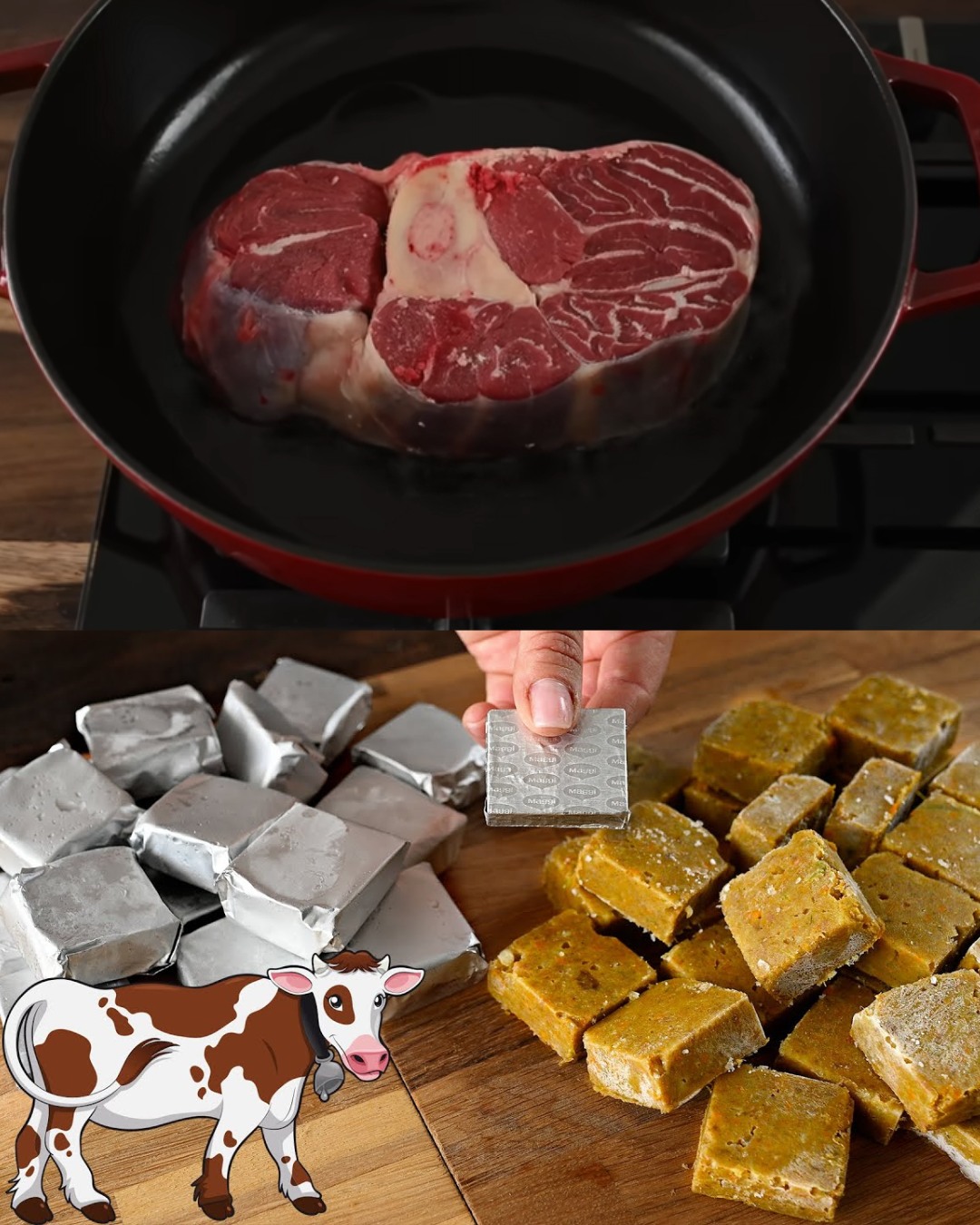There’s something deeply satisfying about a warm, rich beef broth simmered to perfection using wholesome, natural ingredients. Whether you’re looking to enhance your soups, stews, and sauces or enjoy a comforting cup on a chilly day, this homemade beef broth recipe is your go-to guide. Unlike store-bought versions, this broth contains no preservatives or artificial additives, giving you pure, unadulterated flavor. Let’s dive into the art of making the ultimate beef broth from scratch, a time-honored tradition that brings out the best in beef and vegetables.
Ingredients
- Beef Shank: 700 g (1 lb 8¾ oz)
- Why Beef Shank? The beef shank, cut from the leg of the cow, is rich in connective tissue and bone marrow, which breaks down during cooking to create a gelatinous, flavorful broth. This cut is ideal for broth-making, as it adds both depth of flavor and body to the final product.
- Vegetable Oil: 2 tbsp (for searing)
- Why Sear the Meat? Searing the beef shank before simmering caramelizes the exterior, locking in juices and enhancing the broth’s overall flavor through the Maillard reaction—a chemical reaction between amino acids and reducing sugars that gives browned food its distinctive taste.
- Turnip Greens: 1/2 bunch, chopped
- Adding Bitterness: Turnip greens contribute a subtle bitterness that balances the rich, savory notes of the beef, adding complexity to the broth.
- Onion: 1, peeled and quartered
- Flavor Foundation: Onions are essential in broth-making, providing a sweet, aromatic base that enhances the broth’s overall flavor profile.
- Garlic: 3 cloves, smashed
- Why Smash the Garlic? Smashing garlic cloves before adding them to the broth releases their essential oils more effectively, infusing the broth with a deep, savory aroma.
- Parsley Root: 1, peeled and chopped
- Earthy Sweetness: Parsley root, less common but highly flavorful, adds an earthy sweetness to the broth, complementing the richness of the beef.
- Carrots: 2, peeled and chopped
- Natural Sweetness: Carrots contribute a natural sweetness, balancing the savory elements of the broth and adding a subtle hint of color.
- Celery Root: 1/2, peeled and chopped
- Depth of Flavor: Celery root, or celeriac, offers a more concentrated flavor than celery stalks, adding a deep, earthy undertone to the broth.
- Celery Sticks: 4, chopped
- Fresh, Herbal Notes: Celery stalks bring fresh, herbal notes, brightening the broth’s flavor.
- Leek: 1, cleaned and chopped
- Mild Sweetness: Leeks offer a milder, sweeter onion flavor, blending harmoniously with other vegetables without overpowering the broth.
- Parsnip: 1, peeled and chopped
- Nutty Sweetness: Parsnips add a unique nutty sweetness, enhancing the broth’s overall complexity.
- Turmeric Root: 1 piece, about the size of a thumb, peeled and sliced
- Golden Glow and Health Benefits: Fresh turmeric root not only imparts a golden hue to the broth but also adds anti-inflammatory properties and a subtle, warm flavor.
- Salt: 80 g (¼ cup)
- Essential Seasoning: Salt is crucial in bringing out the flavors of the meat and vegetables. It also acts as a preservative, helping to extend the shelf life of your broth.
- Allspice: 1 tsp
- Spice Complexity: Allspice, often described as a blend of cinnamon, nutmeg, and cloves, adds warmth and depth to the broth.
- Bay Leaves: 4
- Herbal Aroma: Bay leaves are traditional in broth-making, lending an aromatic, slightly floral note that enhances the overall flavor.
Directions
1. Prepare the Beef Shank:
- Heat the Oil: Begin by heating 2 tablespoons of vegetable oil in a large, heavy-bottomed pot over medium-high heat. A heavy pot, like a Dutch oven, is ideal for retaining and evenly distributing heat.
- Sear the Beef: Once the oil is hot, carefully add the beef shank to the pot. Sear the beef on both sides until a deep brown crust forms. This step should take about 4-5 minutes per side. Searing the meat locks in its juices and enhances the broth’s flavor, creating a rich base.
- Tip: Avoid overcrowding the pot, as this can prevent the meat from browning properly. If needed, sear the beef in batches.
2. Add Water:
- Cover the Beef: After searing, pour enough water into the pot to almost completely cover the beef shank. Typically, you’ll need about 8-10 cups of water.
- Simmer Slowly: Cover the pot with a lid and reduce the heat to low. Allow the beef to simmer gently for about 2 hours. This slow simmering extracts all the flavors from the beef while keeping the broth clear and rich.
- Tip: Keep an eye on the pot, and skim off any foam or impurities that rise to the surface. This helps to maintain a clear, clean broth.
3. Prepare the Vegetables:
- Wash and Chop: While the beef is simmering, take the time to wash and chop the vegetables:
- Turnip Greens: Roughly chop 1/2 bunch of turnip greens. These will add a slightly bitter note that complements the rich beef.
- Onion: Peel and quarter 1 onion. Onions are essential for building flavor in the broth.
- Garlic: Smash 3 cloves of garlic. Smashing releases more flavor than simply chopping.
- Parsley Root: Peel and chop 1 parsley root. It adds a unique earthy sweetness.
- Carrots: Peel and chop 2 carrots. Carrots provide natural sweetness.
- Celery Root: Peel and chop 1/2 celery root for an intense, earthy flavor.
- Celery Sticks: Chop 4 celery sticks to add fresh, herbal notes.
- Leek: Clean and chop 1 leek for a mild, sweet onion flavor.
- Parsnip: Peel and chop 1 parsnip for a nutty, sweet undertone.
- Turmeric Root: Peel and slice 1 piece of turmeric root, about the size of a thumb, for color and warmth.
4. Add Vegetables and Seasonings:
- Combine Ingredients: Once the beef has been simmering for about 2 hours and is tender, add all the prepared vegetables to the pot. The combination of these vegetables will infuse the broth with layers of flavor, making it robust and well-rounded.
- Season the Broth: Sprinkle in 80 g (¼ cup) of salt, 1 tsp of allspice, and 4 bay leaves. These seasonings will deepen the flavor of the broth, giving it a complex, aromatic profile.
- Sauté and Simmer: Stir the vegetables and beef together in the pot. Sauté the mixture over medium heat for about 5 minutes, allowing the vegetables to brown lightly and release their natural juices. This step intensifies the flavor of the broth.
- Tip: Stir occasionally to prevent the vegetables from sticking to the bottom of the pot.
- Simmer Again: After sautéing, reduce the heat to low, cover the pot, and simmer gently for another 12-15 minutes. This final simmer allows the flavors to meld together, creating a broth that is rich, flavorful, and deeply satisfying.
5. Cool and Freeze:
- Cool the Broth: Once the broth has finished cooking, remove the pot from the heat and allow it to cool to room temperature. Cooling the broth slowly helps preserve its flavor and clarity.
- Strain the Broth: For a clear broth, strain the liquid through a fine-mesh sieve or cheesecloth to remove the solids. This step ensures a smooth, clear broth that’s perfect for sipping or using in recipes.
- Freeze: Transfer the cooled broth into silicone molds, ice cube trays, or any other freezer-safe container. Freezing the broth in small portions allows you to use only what you need, reducing waste.
- Tip: If you don’t have silicone molds, line a regular baking sheet with double-sided baking paper or aluminum foil and pour the broth onto it. Once frozen, break it into pieces and store them in a freezer bag.
- Store: Once frozen, the broth cubes can be stored in a resealable freezer bag or airtight container. Properly stored, the broth will keep in the freezer for up to 3 months.
6. Ready to Serve:
- Defrost as Needed: When you’re ready to use the broth, simply defrost the desired amount in the refrigerator overnight or warm it gently on the stovetop. The broth can be used as a base for soups, stews, sauces, or even enjoyed on its own as a nourishing drink.
- Tip: To quickly defrost, place the frozen broth cubes in a pot and heat them over low heat until melted.
- Enjoy Your Homemade Beef Broth: With its rich flavor and natural ingredients, this homemade beef broth is sure to become a staple in

